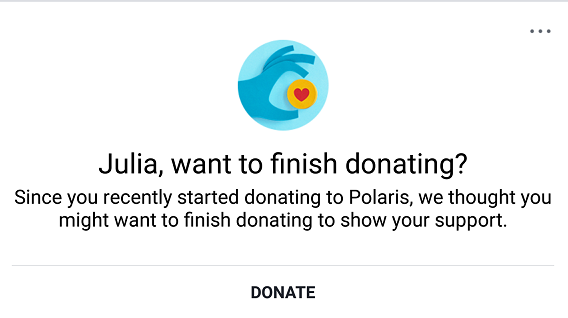 Nonprofits – it’s about time that I provide some tough love and real talk about a controversial, divisive issue facing our nation:
Nonprofits – it’s about time that I provide some tough love and real talk about a controversial, divisive issue facing our nation:
Let me know if any of this sounds familiar.
Here are the top 5 most common laments that I hear on a daily basis from nonprofit fundraisers, marketers, and social media managers:
- It’s so hard to get new donors to pay attention.
- We can’t seem to reach younger donors.
- Our Facebook engagement is way down – no one sees our posts!
- Cutting through the clutter seems impossible, especially on social media.
- Nonprofits can’t actually raise money on social media, can they?
More often than not, as a solution to these very common nonprofit problems, I recommend checking out some of the more popular social media fundraising tools available.
Namely Facebook Fundraising tools, including Facebook Fundraisers, and the newly released suite of YouTube Giving tools.
The reaction from nonprofit professionals is often one of shock, disgust, and/or disbelief.
“Use FACEBOOK for FUNDRAISING??????
But they don’t give you the email addresses of the people who donate. What good is it then?
Our donors are old, and they would never go for this. Nope, this is NOT for us.”
At this point, I like to present them with a photo of a poster that I took in my daughter’s 4th grade classroom. It depicts a GROWTH MINDSET over a FIXED MINDSET.

Want new donors?
Last year on #GivingTuesday, 473,000 donors gave to nonprofits via Facebook fundraising tools, and THREE-QUARTERS of these donors had not previously donated via Facebook.
The majority of Americans now use Facebook (68%) and YouTube (73%). (Source: Pew Internet)
Want to reach younger donors?
YouTube is the most popular social media channel with the younger crowd, with 94% of American 18- to 24-year-olds watching videos on the site.
And yes, even the younger crowd is using Facebook – Pew Internet found that 80% of 18- to 24-year-olds used the site. (Source: Pew Internet)
Want more Facebook engagement?
We know that Facebook is trying to reshape its image.
This means less content in the News Feed that inspires what they call “passive consumption.”
Facebook itself said that it is going to elevate and promote posts that “spark conversations and meaningful interactions between people” – enter more fundraising!
Want to cut through the noise?
When a potential donor goes to your website and clicks on the Donate now button, but doesn’t complete the donation, what happens?
My bet is that nothing happens. Most nonprofit websites aren’t set up to optimize conversions in this way.
On Facebook, they send a notification REMINDING the person to finish the donation.

Facebook also promotes any and all fundraising initiatives that they think you may be interested in – from friends, from family members, from colleagues, and from causes that you care about.
Want to actually use social media to raise money?
Google/YouTube and Facebook designed these tools to make it easier for their users to contribute to the causes that they care about.
They also created them to make it easier for people to start their own fundraising campaigns, and connect their passions with others on the site.

Yes, these social media platforms are businesses.
But that means that they have a big incentive to see their shiny new features SUCCEED.
They want people to adopt them – to donate, to share, to start their own campaigns.
What we need to come to terms with is that the nonprofit is no longer in control of the fundraising medium.
It’s no longer about the nonprofit’s agenda. It is entirely user-facing, user-first.
Adapt or Get Left Behind
Nonprofits spent YEARS complaining that:
- Social media is worthless for development;
- It doesn’t provide direct measurable ROI;
- It’s impossible to drive donations on these sites.
However, now that Facebook and YouTube are providing the tools to get donations, actively encouraging their BILLIONS of users to adopt them, and not taking even a tiny percentage via fees, nonprofits are complaining because these tools aren’t perfect!
Like anything else, perfect is the enemy of the DONE.
Facebook Fundraising tools, and the newly announced YouTube Giving suite of tools, are going to disrupt traditional fundraising methods and the entire nonprofit ecosystem.
Let me be clear – I don’t think that social media fundraising will REPLACE the old, tried-and-true ways of raising money.
But I do have news for you. Giving money on social media is already happening.
It’s not a future trend. It’s reality. And it’s here to stay (for the foreseeable future at least).
Your donors, your supporters, your stakeholders – they are using social media. (Just look at the most recent report on social media use from Pew Internet if you don’t believe me.)
You can stand there and curse the sky, or you can figure out how to best embrace these tools to benefit your supporters and your mission.
For actionable ways that you can harness the power and potential of Facebook Fundraising tools to drive donations, read these posts:
6 Steps to Get Your Supporters Fundraising on Facebook this #GivingTuesday (and beyond)
5 Ways to Improve Your Nonprofit Fundraising On Facebook
How To Use Facebook’s Free Fundraising Tools on #GivingTuesday
Nonprofits + Facebook Ads = More Money Raised!

Launching a strategic, targeted Facebook Ad campaign can set you apart and help you reach a brand new audience.
The Nonprofit Facebook Ad Planner is designed as a simple guide to help you plan, create, launch, and measure a wildly successful Facebook Ad campaign to achieve your nonprofit’s objective, whether it be raising awareness or raising money.
Sign up now to get instant access!

Comments 2
Another great piece with valuable information we can use right away. Thank you!
Author
Thank you!